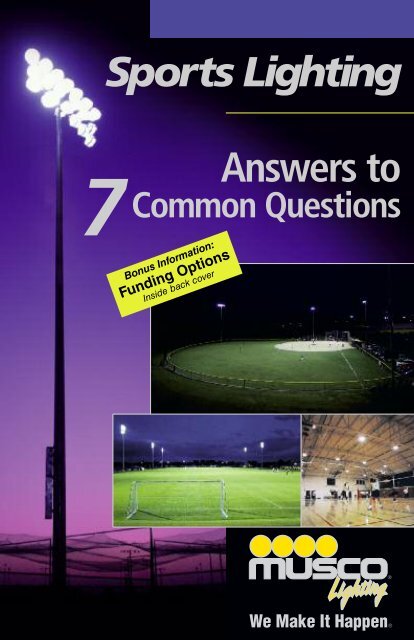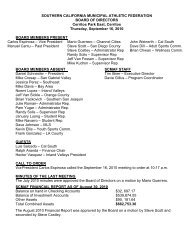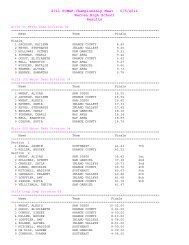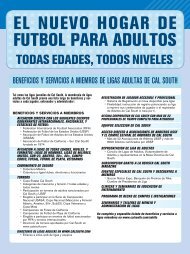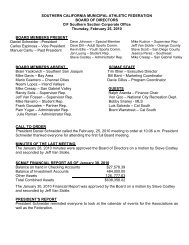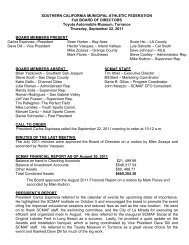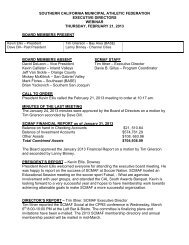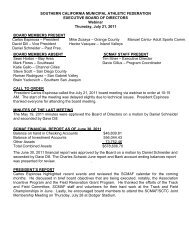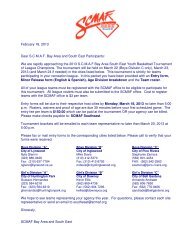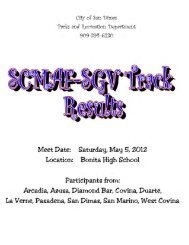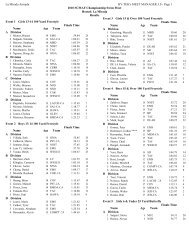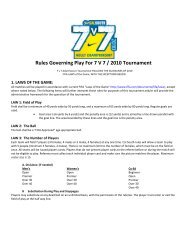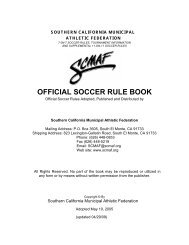Musco Sports Lighting Brochure - SCMAF
Musco Sports Lighting Brochure - SCMAF
Musco Sports Lighting Brochure - SCMAF
You also want an ePaper? Increase the reach of your titles
YUMPU automatically turns print PDFs into web optimized ePapers that Google loves.
<strong>Sports</strong> <strong>Lighting</strong>7Answers toCommon QuestionsBonus Information:Funding OptionsInside back cover
Decisions ... decisions ... decisions.There are more decisions than you may realize in planning a sports-field lightingproject. As the decision maker, the standards you set will affect recreation or athleticprograms in your community for 20 to 30 years.Obviously, you want your decisions to result in a trouble-free lighting system thatwill be a safe, energy-efficient source of pride rather than a disappointing source ofcontinuing high-maintenance headaches and neighbors’ complaints.<strong>Lighting</strong> an outdoor sports facility is a big investment. You and your designconsultant need to ask many questions about initial and long-term benefits to ensureyou get the most value from the dollars you spend. The more you know aboutsports lighting, the better chance you have of getting the results you want.To help get you started with your project, we’ve put together this guide to answerthe most common questions people have about lighting a sports field.Content: Answers to 7 Common Questions1. What affects the cost of lighting my ballfield?.....................................................22. How many lights do I need?................................................................................43. What will it cost to operate my lighting system?.................................................64. If they use the same wattage bulb, aren’t allfixtures the same? ...............................................................................................85. Our local utility company has offered to donate woodpoles. How will these work on my field? ...........................................................106. There are no houses near my field, so why shouldI be concerned about spill light and glare?........................................................127. How can I make sure I get the results I want? ..................................................14
1.What affects the cost of lighting my ball field?Many people don’t realize the cost of light fixtures is only a small part of the overallproject cost. When comparing proposals, it is important to look at both the initialand operating (or life-cycle) costs. (See pages 6 and 7 for more information onoperating costs.)Initial costs for a completeproject will include threecomponents:■<strong>Lighting</strong>■Structural■ElectricalFor each of these threecomponents you will needto select someone to:■Design■Supply■InstallDecisions you make on one component affect the others. For example, due tovariances in fixture efficiency, some manufacturers may require more light fixtures,which means you may need larger poles to support the additional wind load andadditional electrical components to operate the system.Design9 Important <strong>Sports</strong>-<strong>Lighting</strong> Decisions<strong>Lighting</strong> Structural Electrical? ? ?Supply? ? ?Install? ? ?This matrix is an easy way to see at a glance if you’ve coveredall areas of your project in developing cost estimates.2<strong>Musco</strong> provides■ Free project planning assistance and budget estimates■ Complete systems engineered for fast, cost-savinginstallation■ Energy efficient systems that save 50% in operatingcosts over the life of the system■ Ways to reduce your total project costs by up to 1⁄3 withvolunteer-assisted installation■ Fundraising and financing programs
In addition to the nine important sports-lighting decisions, several variables affectthe design and final cost of your project. The following is a checklist of the majoritems that will need to be reviewed with your local sports-lighting representativeand incorporated into your lighting system design.Quantity and quality of light❏ Facility type❏ Players’ skill level❏ Facility size❏ Spectator capacity❏ Television/video requirements❏ Required or recommended lighting standards (fororganizations such as Little League Baseball® and Softballor Amateur Softball Association)Geographical issues❏ Location — affects structural codes and local/statebuilding codes❏ Soil conditions❏ Existing structures❏ Pole setback requirementsEnvironmental light control issues❏ Proximity of neighbors❏ Community light ordinances❏ Nearby airport or observatory ordinances❏ Multifield complexes3
2. How many lights do I need?It is a common practice to specify a number of fixtures, rather than the amount oflight produced on the field. However, this is like buying a car based on the size ofits gas tank rather than its fuel efficiency. The efficiency of reflector systemscurrently available varies significantly. What you are buying is the quantity andquality of light on the field.Quantity of lightLight on a playing surface is measured in footcandles. There are several factors thatdetermine the number of footcandles required to light your field:1. Sport type — More light is required to light smaller, faster moving objects. Forexample, baseball uses a small ball traveling at high speeds and, therefore,requires a higher light level than soccer.2. Players’ skill level — Higher light levels are needed for increased skilland accuracy.3. Field size — Defines the number of square feet to be lighted.4. Spectator capacity — More light is needed to see action that is farther away.5. Television/video requirements (if any) — A camera interprets images more slowlythan the human eye and requires more light to be able to follow the action.4Generally Accepted <strong>Lighting</strong> StandardsLIGHT LEVELSFOOTCANDLESLUXTarget 1 / Target 1 /Constant Initial Constant InitialBaseball/SoftballRecreational 30/20 43/29 323/215 462/308Schools/Amateur Leagues 50/30 71/43 538/323 768/462Little League Baseball® 50/30 71/43 538/323 768/462Amateur Softball Association (ASA) 50/30 71/43 538/323 768/462College 2 100/70 143/100 1076/753 1538/1076Basketball (indoor)Elementary 30 43 323 462High School 50 71 538 768College 2 80 114 861 1230FootballSchools/Amateur Leagues 30 43 323 462College 2 50 71 538 768SoccerSchools/Amateur Leagues 30 43 323 462College/Municipal 2 50 71 538 768Tennis - 2 court (side by side)Recreational 30 43 323 462Schools/Amateur Leagues 50 71 538 768College 2 75 107 807 11521.7 light loss factor used to determine target light levels on field for extended life of lighting system.2May vary due to seating capacity and television requirements.
Light levels naturally depreciate over time as lamps age. New technology offsets this,but it is important to make sure your system is designed to provide maintained, ortarget, footcandles to ensure you have enough light over the life of your lighting system.<strong>Lighting</strong> terms you’ll hearLumen — A measure of light, much like a mile is a measure of distance.Footcandle — One lumen of light spread over one square-foot of surface. In otherwords, a light level of 30 footcandles means that 30 lumens of light are beingprojected onto each square foot of playing surface.Initial footcandles — The amount of light on the field when the lighting system isfirst put into use.Target footcandles — The lowest average amount of light for which a lighting systemshould operate over its extended life to ensure performance requirements.Constant light levels — The amount of light you can expect on the field at anygiven time over the extended life of the system.Uniformity — The smoothness of light on the field.Photometrics — The reflector is the photometric unit of a lighting system. Itprovides a mechanical redirection of light.High intensity discharge lamp (HID) — A group of lamps consisting of metal halide,mercury, and high pressure sodium.Light loss factor — A factor used to calculate the level of light after a given periodof time. Accounts for lamp depreciation, dirt accumulation, temperature and voltagevariations, and maintenance procedures.Point-by-point — A computer-generated model of your proposed lighting systemshowing footcandle readings at given points on your field.Quality of lightWhen talking about quality of light on the field, you’ll hear the term uniformity, orevenness, of light on the field. It is stated as a ratio, like 3:1, the minimum standardfor most sports.What it means: the brightest point on the field should be no more than three timesthe darkest point. Why is that important? Balls appear to change speeds if they passfrom dark to light areas, making it difficult to follow the flight and gauge the speedof the ball.Each manufacturer should provide specificinformation on initial and maintained lightlevels as well as a uniformity ratio, so when youcompare proposals you can be sure they’re alldesigned to the same criteria.It’s also a good idea to get written guaranteesfor both the quantity and quality of light yoursystem will provide.<strong>Musco</strong> provides■ Free lighting designservices to you oryour consultant■ Guaranteed constantlight levels5
3. What will it cost to operate mylighting system?Several issues affect the operating cost of a lighting system. In addition to theelectrical cost of lighting your field, you should consider management and staff timefor operating the on/off schedules and tracking facility usage. Routine maintenanceand unexpected repair costs can rack up if your system is not well designed from anelectrical and structural standpoint.Electrical consumptionDifferences in reflector system efficiencies and aiming design can vary, meaning onemanufacturer may require fewer fixtures to achieve the same amount of light on thefield. Over the life of the system you’ll save money on electrical costs with fewerfixtures, and you’ll save on lamp replacement and other maintenance costs.In the example, Manufacturer A saves $41,500 in energy cost over the life of the system.300-foot Radius Baseball Field (1500-watt metal halide lamps)Manufacturer A – 32 fixturesManufacturer B – 52 fixtures32 fixtures Number of fixtures required 52 fixturesx $.14* Hourly cost per fixture x $.15*$4.48 Hourly energy cost $7.80x 500 hours Hours operated per year x 500 hours$2,240 Annual energy cost $3,900x 25 years Life of system x 25 years$56,000 Life-cycle energy cost $97,500Efficient management and schedulingAs public concern over energy conservation grows, many cities and organizationsare implementing automated lighting control systems to turn their lights on and off.The automated systems are more reliable than timers and better at accommodatinglast minute changes or rainouts. Also, operating lights only when needed will savesubstantial energy dollars over time, especially for multiple fields.In addition to the energy savings,automated control systems can save yourstaff traveling to and from the ballparksevery night to turn lights on and off. Somesystems provide advance weekly planningand management reports that track hoursby user, helping you set user fees thatoffset your operating expenses.6* Assuming a 9¢ kWh electrical rate, Manufacturer A uses an average of 1.564 kW per fixture, andManufacturer B uses an average of 1.62 kW per fixture.<strong>Musco</strong>’s Control-Link®automated control system■Saves energy and staff costs■Allows flexible control■Improves management tools■Increases security■Provides reliable operation
Routine maintenanceRelamping — It’s more efficient to “group” relamp rather than replace lamps as theyburn out. We recommend group relamping prior to the end of the rated lamp life.Costs include:■Lamps ($60 – $70/lamp average)■Equipment rental to get to top of pole ($60 – $125/hour)■Labor (Approximately $40 / hour average)Fuses — Replace as needed (average cost $1 – $5 / fuse). Unless fuses are accessibleat ground level, you may also need to rent equipment to get to the top of the pole(see above).Repair and unexpected costs — how to avoid themThese costs may be overlooked during the initial purchase of a lighting system, butcan take significant time and money to correct later. A well-designed system will bedurable enough to withstand the elements and have features designed to reducelabor costs.Re-aiming — Make sure your manufacturerguarantees fixture alignment. Over time,several factors, including the weather, cancause misalignment resulting in less light onthe field. Labor and equipment costs tocorrect this can be significant.Multiple fixture outages — Each fixtureshould be individually fused. This lessens thechance of a multiple or “gang” failure andalso the need for emergency repairs.Troubleshooting — Easy-to-access systems aredesigned so the major electrical components— ballasts, capacitors, and fuses — are locatedclose to the ground, saving time and money.Misalignment of as little as 10 degrees shiftslight off the playing field into the stands.<strong>Musco</strong> Constant 25 , a comprehensive foundation-to-poletopwarranty and maintenance program, covers 100% of yourmaintenance costs, including parts and labor, for the next25 years.<strong>Musco</strong> Constant 25 includes■ Guaranteed constant light levels■ Group lamp replacements■ System monitoring■ Routine maintenance and on/off control servicesHaving major electricalcomponents accessible atground level avoids hiring a$100 crane to replace a $1 fuse.7
4. If they use the same wattage bulb, aren’tall fixtures the same?All 1500-watt metal halide bulbs produce about the same amount of light(155,000 lumens). However, without a reflector, a 1500-watt metal halide bulbproduces less than one footcandle of light on an area 100 feet away.The manufacturer’s reflector design is the critical factor in how effectively the lamp’slight energy is projected onto the playing surface. New technology allows previouslywasted spill light to be redirected back onto the playing surface, increasing the lighton the field.1500-watt metal halidebulb with no reflector0.32 Footcandles100 Feet1500-watt metal halidebulb with reflectorA reflector concentratesand projects the light energyonto the playing surface.11 Footcandles100 FeetIt is a common mistake to specify a number of fixtures, rather than the quantity oflight produced on the field. Specifying a set number of fixtures simply spells out theamount of light that is going to be generated by the lamp at the top of the pole,rather than the light on the field.8<strong>Musco</strong>’s Technology■Provides more light per fixture on the playing surface — fewerfixtures to buy, install, operate, and maintain■Reduces spill light and glare off-field by 50%; reduces fixture glarefor players■Ensures guaranteed Constant Light for the safety and performance ofplayers without wasting energy■Offers complete foundation-to-poletop lighting system
Fixtures may be purchased as a system or as single fixtures. Here’s an analysis:Shaded areasindicateengineeredcomponentsSystemEngineered as a total system■Parts selected by trainedengineers for system compatibility■Critical components assembled incontrolled environment■Tested prior to shipment■Single source accountability withwarranty on entire systemSingle FixtureParts and pieces of unknown strengths puttogether by the installer■Inconsistent warrantiesfrom several sourcesFactory aimed■Reduced installation cost■Known resultsIndividual fixture-by-fixture aiming from thetop of the pole■Adds installation cost■Unknown results40+ pound ballast mountedat base of pole■Easier maintenance■Weight reduction assuresfixture alignment40+ pound ballast mounted on fixture■Troubleshooting must be donefrom top of pole■Increases chance ofmisalignment9
5. Our local utility company has offered todonate wood poles. How will these workon my field?While it’s tempting to use wood poles, you’ll find any initial savings are quicklyeaten up in repairs and re-aiming fixtures. Here are some of the problems we’veobserved on facilities that used wood poles.Improper mounting heightsIn general, wood poles that are donated are not tall enough to allow for propermounting heights required for sports lighting. Poles that are too short cause glarefor players and spotty lighting on the field.Fixture misalignmentTwisting poles — As wood poles dry in the sun, they naturally twist. Today’s lightingsystems are aimed to 1 ⁄2° accuracy, but wood poles commonly twist 15° – 20° in eitherdirection. Re-aiming fixtures is a costly maintenance chore that can be avoided.Leaning poles — Wind load created by the fixtures at the top of the pole make astandard utility embedment (10% plus 2 feet) inappropriate for a sports-lightingapplication. As a result, your poles may begin to lean, misaligning your fixtures.Safety hazardsTwisting poles — Because electrical conduit must be run on the outside of the pole,twisting of a wood pole can result in exposedwiring.Rotting wood — The center of treated woodpoles are the most susceptible to deterioration,which means you may unknowingly have a polethat is in danger of failing.Woodpeckers — Woodpeckers can create largeholes in wood poles, making them structurallyunsafe. (It sounds funny, but it does happen!)Toxic preservatives — Effective woodpreservatives are made from a variety ofmaterials inappropriate for use in areasof high activity.10Twisting of this pole caused electricalconduit to separate, exposing wiring.
Other common pole types are concrete and steelPole Type Benefits DrawbacksConcrete ■Can be direct buriedeliminating the cost ofelaborate footings■Corrosion andmoisture resistant■Pleasing appearance■■Poles are heavier and moreexpensive to setHigh freight costs often limittheir use to areas near concretepole manufacturing plantsBase-plateGalvanized Steel■■Pleasing appearanceLightweight, easy to handle■■■■■Higher initial costRequire construction of concretefoundations with anchor bolts onwhich poles are mountedCuring time of concrete baseCorrosion at ground levelDifficulty with pole orientationDirect BurialGalvanized Steel PoleBenefits■■■■Pleasing appearanceLightweightInstallation ease — Poles can normally beset onto pre-stressed, direct-buried baseswithin 24 hours, eliminating the up to 28-daycure time and extra expense for designingand fabricating on-site built foundations.Cost savings — Poles and bases are shippedin sections, lightweight and easier to handlefor lower freight costs and faster installation.Corrosion resistance — Concrete basesprovide maximum corrosion and moistureresistance at ground level and below grade;galvanized steel poles kept above acceleratedcorrosion zone (two feet above and belowground).■■Underground corrosionaccelerated due to moisture andsoil chemicals — oftenundetectable prior to pole failureIncreased installation time andcost depending on structuralengineer’s criteriaCombination concrete and steel poleThis pole option combines the advantages of steel and concrete, while reducing oreliminating many of the problems. Steel pole shafts are slip-fit onto precast concretebases that are set directly into the ground and backfilled with concrete.■<strong>Musco</strong>’s Light·Structure Green Combines the benefits of bothconcrete and steel poles —reduces installationcosts and time11
6. There are no houses near my field, sowhy should I be concerned aboutspill light and glare?Even if there aren’t any houses there now, controlling spill light and glare isimportant for several reasons:■■■■Spill light is wasted energySpill light and glare control technology will improve the quality of light on thefield for players and spectatorsCommunities often “grow-up” around recreational facilitiesCommunities are becoming increasingly concerned about environmental lightcontrol and energy consumptionSpill light = wasted energyPrior generation, standard symmetrical reflectors actually waste light. Light controltechnology redirects wasted spill light back onto the playing surface, increasing lighton the field.By better controlling the light from each fixture, you reduce the number of fixturesneeded to get the required amount of light on the field. This, in turn, reduces theelectrical cost to operate and maintain the lighting system.Old GenerationNew TechnologyPrimary Lightoff-fieldspill lightPrimary Lightless spilloff-fieldPrimary LightPrimary Lighton-field lightmore light on-fieldStandard Symmetrical ReflectorRedirects Off-Field Spill Light12
Glare problemsGlare control is not only importantfor off-site locations, it is also criticalto player safety and spectatorenjoyment. Glare from fixturescan make it difficult for playersto follow the ball, creating thepossibility for injury.Players competing on multifieldcomplexes can also be affected byglare from adjacent fields.Community growthOld Generation StandardSymmetrical ReflectorNew Technology — getsthe glare out of players’eyesOften communities “grow up” around sports facilities. The fact that the facilitiesand the lights were there first doesn’t stop the new neighbors’ complaints whenlights are shining into their living rooms. Your lighting system should last over20 years, plenty of time for growth to become an issue in many communities.Growing concernWe’re all aware of the growing public concern for wasting the valuableenergy resources it takes to produce light. Many communities are also enactingenvironmental light pollution ordinances to regulate bothersome light that shineson private property, through windows, onto roadways, and around astronomicalresearch facilities.<strong>Musco</strong>’s Technology<strong>Musco</strong> has developedadvanced spill lightand glare controlsystems to solveserious environmentalconcerns.13
7. How can I make sure I get theresults I want?We’ve reviewed some of the issues involved in choosing the sports-lighting systemthat will meet your needs. Once you’ve made your decision, there are ways toensure you get the results you want:Define standardsIt is important to have written specifications that establish the performance thatyou want from your system.When defining specifications, remember to incorporate the three components ofa lighting system: lighting, structural, and electrical. Take into account the costsinvolved for the design, supply, installation, and operation of the entire system.Specify the values you want for playability, environmental light control, life-cyclecost savings, and warranty.Clear cut standards avoid two problems on bid date:■Insufficient, cheap equipment substitutions to lower bid price■High bids to cover the uncertain costs of an under-defined projectSeek accountabilityHaving a manufacturer that stands behind their product and provides good servicewill make a huge difference in long-term satisfaction with your lighting system:Get a written guarantee — Manufacturers can provide written performanceguarantees that your entire system — from the foundation to the light fixtures —will meet the specifications you established. Getting this guarantee from a singlesource that provides your entire system can save you the headache of sorting outresponsibility among multiple manufacturers should a problem arise.Compare warranties — The warranty reflects a manufacturer’s confidence in theirproduct. Some manufacturer warranties include routine maintenance and providelonger coverage based on their confidence in their product’s performance.Evaluate their reputation for service — Ask for project references and review themanufacturer’s track record for service. Find out if there will be an on-site fieldperformance evaluation after the installation.14<strong>Musco</strong> <strong>Lighting</strong>■■■Provides local representatives to assist you in developingwritten specifications to ensure the performance of yoursports-lighting systemOffers an industry-leading 25-year product assurancewarranty and maintenance programProvides dedicated warranty and field services personnel
We’ll help get you started.Whatever the size of your project, <strong>Musco</strong> provides the same quality equipment andexpert engineering. Our technology provides unequaled performance:■Reduces energy and life-cycle costs by 50%■Eliminates 100% of maintenance for 25 years■Cuts wasted spill light by 50%■■Provides constant light levelsControl·Link® provides system monitoring, management tools, andon/off controlFor free planning assistance foryour sports-lighting project contact800/825-6030www.musco.come-mail: lighting@musco.com15
16Notes
Funding options to help make yourproject happenFinding available funds is often the most challenging part of the buying process.There are options available that can make your lighting project doable.Utility grants/rebatesMany utility companies offer incentives to promote the use of energy efficient productsincluding athletic field lighting. Incentives vary and come in the form of rebates, grants,low-interest loans, or reduced kilowatt rates. Once the utility company completes anenergy savings audit, they can help fund new lights or upgrade your existing lightingequipment with an energy-efficient system.Financing ProgramsFinancing programs for municipalities and public school systems provide a “budgetstretcher” to help with facility improvements such as sports lighting and otherequipment. The added revenue from expanded use of your facility can help makethe annual payments, allowing you to enjoy the benefits of lighted facilities sooner.Plus, a set payment can be built into your annual budget, freeing you from budgetuncertainties and lowering the cash flow impact of a large purchase.Unique Fundraising<strong>Musco</strong>’s unique Pennant Program provides corporate advertising opportunities usingpennants displayed on <strong>Musco</strong>’s Light-Structure Green systems. Many organizationshave used this program to totally finance their project or to complement otherfundraising efforts. Others have continued the program after the initial purchase tohelp with annual operating costs.Volunteer InstallationBonus InformationReducing installation time can save significant total project costs. Buying the componentsfrom one manufacturer as a complete, compatible system makes installation simpler,saving time and money. Plus, systems suitable for volunteer installation can save upto one-third of the total project costs.<strong>Musco</strong> <strong>Lighting</strong>■ Has a resource database to help identify recreation, utility, and communityfoundation incentive programs available in your area■ Meets utility companies’ eligibility requirements with its Light-Structure Green and Control-Link® energy and life-cycle cost savings■ Offers flexible, affordable financing programs for qualified applicants■ Provides Pennant Program material and other fundraising tips■ Offers a lighting system that makes volunteer installation possible
w w w . m u s c o . c o m800/825-6030www.musco.come-mail: lighting@musco.com100 1st Avenue West / PO Box 808Oskaloosa, Iowa 52577641/673-0411 • Fax: 641/672-1996©1996, 2009 <strong>Musco</strong> <strong>Lighting</strong> · E-100-12


